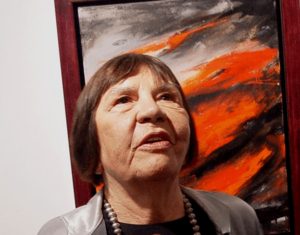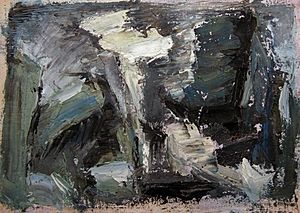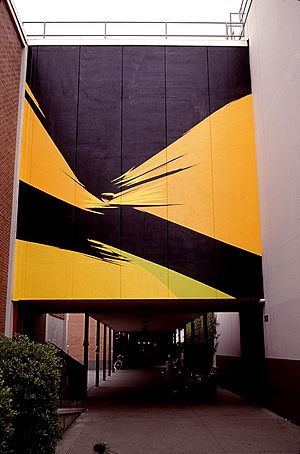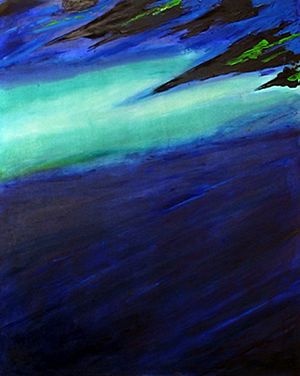Rita Letendre facts for kids
Quick facts for kids
Rita Letendre
|
|
|---|---|

Letendre in 2008
|
|
| Born | November 1, 1928 Drummondville, Quebec, Canada
|
| Died | November 20, 2021 (aged 93) |
| Education | École des beaux-arts de Montréal |
| Movement | Les Automatistes |
| Awards | Order of Canada (2005); Governor General's Award (2010); Queen Elizabeth II Diamond Jubilee Medal (2012) |
Rita Letendre (November 1, 1928 – November 20, 2021) was a famous Canadian painter. She was also known for creating large wall paintings called murals and for making prints. Rita Letendre was part of two important art groups in Canada: Les Automatistes and the Plasticiens. She received many top awards, including the Order of Canada.
Contents
Early Life and Art School
Rita Letendre was born in Drummondville, Quebec. She was the oldest of seven children. Her family had Abenaki and Québécois roots. Life was often hard for her family.
When she was 19, Rita was working at a restaurant in Montreal. A customer saw her drawings and was very impressed. He encouraged her to join the École des beaux-arts de Montréal, which was an art school. Rita had never heard of it, but she decided to go. She was accepted after a test.
At the school, she met other artists. She learned about different art styles. In 1950, she saw an art show called "L’Exposition des Rebelles." This show introduced her to a group of artists called Les Automatistes. Soon after, she left the art school to follow her own path.
The Automatistes Art Group
Paul-Émile Borduas was a key leader of Les Automatistes. He greatly influenced Rita Letendre. This group believed that artists should paint from their feelings and instincts. They thought art should come from deep inside.
At first, Rita painted pictures that looked like real things. But by 1951, she started painting in an abstract way. This means her art did not show real objects. Instead, it used shapes, colors, and lines to express ideas. She began showing her abstract paintings in public places.
The Plasticiens Art Group
In 1955, Rita had her first official group art show. Her work caught the eye of Rodolphe de Repentigny. He was an artist and art critic. He was also a main leader of another art group called Plasticiens.
The Plasticiens focused on clear shapes and geometric forms. Rita was impressed by their structured style. She started to change her own art. Her paintings became more geometric. She used strong color areas and clear lines. This was a different approach from the free style of the Automatistes. She showed her work with the Plasticiens in several cities.
New Styles: Zen and Abstract Expressionism
In the late 1950s, Rita Letendre explored new ideas. She studied Zen and Confucius, which are ancient philosophies. These ideas influenced her art. She started painting with black and white lines and strokes.
She was also inspired by Abstract Expressionists in New York. These artists painted with strong, energetic brushstrokes. Rita's paintings became more expressive and bold. She used thick paint applied with a palette knife. Her art became very personal and powerful. She won several art prizes during this time. These awards allowed her to paint full-time.
In 1962, she received a grant and traveled through Europe. This was a very creative time for her. She began to develop her "hard edge" style. This style used clear, sharp lines and shapes. She also traveled to Israel to paint.
Hard Edge Style
In the mid-1960s, Rita Letendre focused on her hard-edge style. She used sharp, diagonal lines, which she called "flèches" (arrows). These lines made her paintings feel full of energy and movement.
She moved to California and received an important job. She painted a large mural called Sunforce on a college building. This mural was a big change for her. She had to adapt her painting style for such a large wall. Sunforce shows a large shape that seems to drop down.
In California, she also learned printmaking. She learned lithography and silk screen. These techniques were perfect for creating her hard-edge shapes.
Later, she moved between New York and Toronto. Her art became very popular. In 1971, she started using an airbrush. This tool helped her create smooth, long lines and rays of color. She found it brought a new feeling to her art.
She received many jobs for large artworks. One famous mural covered six stories of a building in Toronto. She also designed a huge colored skylight for the Glencairn (TTC) subway station in Toronto. It was called Joy. The skylight was removed for a time because the colors faded. But it was fixed and put back in 2014. It still gives a warm, orange glow to the station today.
Pastel Art
In 1980, Rita Letendre started working with pastels. These are soft, colored sticks used for drawing. She created a series of pastel works in 1982. These were inspired by the Nevada landscape. Pastels allowed her to create soft, blended edges in her art.
Return to Oil Painting and Later Years
By 1995, Rita Letendre returned to using heavier oil paints. She stopped using the airbrush. She used brushes, palette knives, and even her hands to create her art. Her husband, Kosso Eloul, passed away that year. She took a break from painting.
In 1997, she started painting again. She continued to develop her unique style. In 2004, she moved back to Montreal. She received many more awards for her art. These included the Order of Canada in 2005 and the Governor General's Award in 2010. She continued to create and show her art even when she was 87 years old.
In 2017, a major art show of her work was held at the Art Gallery of Ontario. It was called Rita Letendre: Fire & Light. This show celebrated her long and important career.
Rita Letendre died on November 20, 2021, at the age of 93.
Awards
- 1959 – First Prize, Concours de la Jeune Peinture
- 1960 - Prix Rodolphe-de-Repentigny
- 1961 - Painting Prize, Province of Quebec
- 1962 - Canada Council Travel Grant (Europe)
- 1962 - Gold Medal, Piccola Europa Exhibition, Sassoferrato, Italy
- 1967 - Research Grant, Government of Quebec
- 1970 - Second International Painting Festival, Cagnes-sur-Mer, France (National Prize)
- 1975 - Canada Council Senior Arts Grant
- 2002 - Officer of the National Order of Quebec
- 2005 - Officer of the Order of Canada
- 2010 - Creation of the Rita-Letendre Tribute Prize by the City of Drummondville
- 2010 - Governor General's Award in Visual and Media Arts
- 2010 – Honorary Ph.D. – University of Montreal
- 2012 – Recipient of the Queen Elizabeth II Diamond Jubilee Medal
- 2016 – Member of the Order of Ontario
Solo Shows
Rita Letendre had many art shows where only her work was displayed. These were held in Canada and other countries. Some important ones include:
- 1974 Rita Letendre: Palm Springs Desert Museum, California
- 1989 Rita Letendre: the Montréal years, 1953-1963, Concordia Art Gallery, Montreal
- 2001 Rita Letendre: Les Elements - The Elements, Galerie Simon Blais, Montreal
- 2003 Rita Letendre: aux couleurs du jour, Musée national des beaux-arts du Québec
- 2005 Rita Letendre: Beginnings in Abstraction, Robert McLaughlin Gallery, Oshawa, Ontario
- 2013 Rita Letendre, Gallery Gevik, Toronto
- 2017 Rita Letendre: Fire & Light, Art Gallery of Ontario, Toronto
- 2021 Rita Letendre: Lines of Strength, Musée du Bas-Saint-Laurent, Rivière-du-Loup
- 2022 Rita Letendre: Eternal Space, Carolyn Campagna Kleefeld Contemporary Art Museum, California
Other solo shows included:
- 1955 Galerie L'Echourie, Montreal
- 1956 Galerie L'Actuelle, Montreal
- 1959 Galerie Denyse Delrue, Montreal (also 1961)
- 1961 Museé des Beaux-Arts, Montreal
- 1961 Here and Now Gallery, Toronto (and Dorothy Cameron Gallery 1962, 1963)
- 1969 Gordon Gallery, Tel-Aviv, Israel
- 1972 The Arwin Gallery, Detroit
- 1972 Museé d'Art Contemporain, Montreal
- 1980 Centre Culturel de Drummondville (also 1998)
- 2001 Centre d'exposition de Baie-Saint-Paul
- 2003 Musée du Québec (also 2004)
- 2004 Winnipeg Art Gallery
Major Collections
Rita Letendre's art is part of many important public collections. These include the National Gallery of Canada in Ottawa. Her work is also at the Art Gallery of Ontario in Toronto. You can find her art in many museums in the United States too.
Record Sale Prices
One of Rita Letendre's large oil paintings, Reflet d’Eden (1961), sold for C$451,250 (about $356,000 USD) at an auction in 2022. This was a record price for her work.
Personal Life
Rita Letendre's early life was challenging. Her family faced financial difficulties. When she was young, she lived with her grandmother for a time. This was a more peaceful period for her. She enjoyed reading and playing.
Later, her family moved to a new community. Here, Rita and her siblings faced prejudice because of their Abenaki heritage. She learned to stand up for herself. To escape the difficulties, she often drew in her schoolbooks. She created her own happy worlds through art.
When her family moved to Montreal, Rita had to help care for her younger siblings. She continued to draw in the evenings. She also loved to read books and listen to opera on the radio. She discovered famous artworks in library books. By 1946, she began working to help her family. She continued to pursue her art whenever she could.
Rita Letendre passed away on November 20, 2021, from blood cancer.





